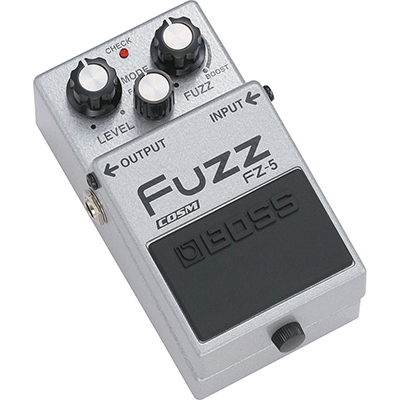
By Ed Malaker
Posted 07/13/2018
Fuzz
Fuzz is a type of distortion that was originally marketed in the early 1960s as a device that can be used to emulate the sound of Orchestra instruments such as the Trumpet, Cello, Bassoon, Saxophone, etc. It was a Saxophone sound that Keith Richards wanted for the beginning of “Satisfaction,” which prompted him to try out a Fuzz pedal. It was also during this time that the Kinks, Link Wray, and many other early Rock & Roll, and Blues guitar players reportedly punched holes in their speakers to get a fuzzy sound. You can hear a torn speaker in “Rocket 88” (the first Rock & Roll song), by Ike Turner and Jackie Brenston. Other notable songs from that time that feature Fuzz are “You Really Got Me,” by The Kinks and “Rumble,” by Link Wray. The aggressive Fuzz tone of this song actually scared listeners, and it was banned from the radio.
Fuzz Pedals
Originals
The first time Fuzz was created electronically and used in a recording was for a song called “Don’t Worry,” by Marty Robbins. The Fuzz effect on this song was created by a faulty preamp in the mixing console. The next year, the producer recreated the effect and sold the design to Gibson. Gibson made the first Fuzz pedal called the Maestro Fuzz Tone FZ1. The British version of this Fuzz effect was the Sola Sound Tone Bender. You can hear this type of Fuzz on many Led Zeppelin and early Rolling Stones songs. The Tone Bender was quickly followed by the Fuzz Face. This was a newer Fuzz pedal that was based on the Tone Bender and made popular by Jimi Hendrix.
Big Muff
Created by Electro Harmonix, the Big Muff PI is another significant Fuzz pedal that’s similar to the others, but unique enough to talk about. The Big Muff PI has been a very popular Fuzz pedal and it’s been used by many great guitar players. Some examples would be David Gilmour, Frank Zappa, and Kurt Cobain. A large portion of the Fuzz pedals available today are re-issued and modified versions of either the Tonebender, or the Big Muff PI Fuzz pedals.
Tonebender Fuzz pedals are very simple by nature and require only a few components: resistors, capacitors, potentiometers, and transistors. There are many easily obtainable, and inexpensive “Make Your Own Fuzz Pedal” kits available if you’d like to try to create your own Tone Bender Fuzz. Tonebender Fuzz has a very midrange tone. It adds some buzz, but the sound of your guitar will still come through. It cleans up nicely when you roll off the Volume on your guitar and it’s sensitive to your playing.
Fuzz Pedal Components
Transistor Types
The main components to the Fuzz are the transistors. Germanium transistors were used before Silicon was introduced. Germanium transistors sound warmer and smoother than Silicon. Also, they are often the preferred transistor for Fuzz, despite reliability issues. Silicon transistors are much more dependable and offer higher gain, but they do have a much more sharp and treble tone. So, although Germanium is making a comeback, Silicon transistors continue to be used in almost all Fuzz pedals, as they have since the late 60s. We review the differences between Silicon and Germanium in greater detail here: “Germanium and Silicon in Fuzz – What’s the Difference?”
The Big Muff PI is a more complex Fuzz pedal (though still buildable). It features four stages of transistors, which combine to create a very thick blanket of Fuzz. Most of the guitar’s signal is transformed by the pedal, leaving little of its original tone. The Volume control does not do much to clean up the effect. What you do get is huge amounts of Fuzz and unbelievable Sustain. The Big Muff also has a Tone control that the Tonebender (original versions) does not have. Although a Germanium transistor version of the Big Muff exists, this Fuzz pedal is almost exclusively made using Silicone transistors.
How Transistors Work
Although the sound of these two types of pedals is very different, they both create their sound using transistors. Transistors are very lo-fi amplifiers that distort and clip quite quickly. Also, they add a lot of harmonic content when they do. The first transistor amplifies the guitar signal and feeds the second transistor a signal that will be too hot for it. So, since the second transistor can’t handle the signal, it clips it. The lo-fi nature of the transistor causes it to add harmonic content to the signal when it clips. The resulting blend of clipped signal and harmonic content is Fuzz. The more transistors you have, the more Fuzz you can create. You can see this with the thick fuzz of the four-stage Big Muff, as compared to the two-stage Fuzz Face.
If you’ve found this article helpful, please feel free to share this with your friends on Facebook and Twitter. For more articles on guitar electronics, visit humbuckersoup.com.
